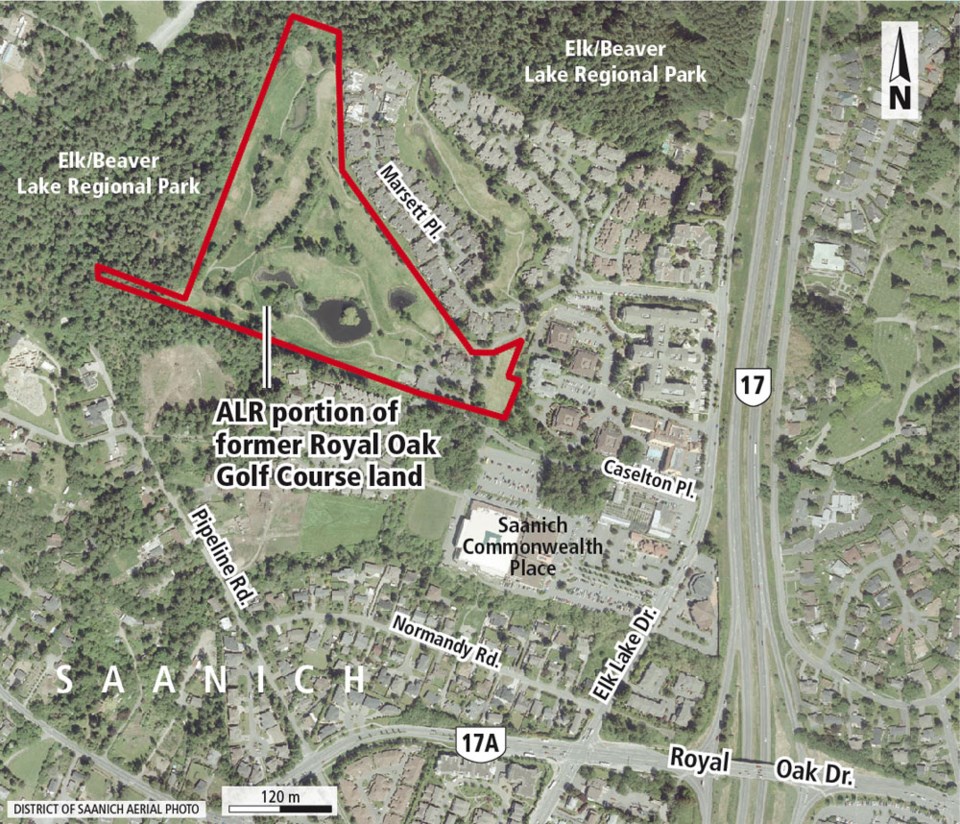The owners of the former Royal Oak Golf Course property in Saanich have postponed their application to remove the land from the provincial Agricultural Land Reserve in order to allow for more consultation with the community.
Saanich council was set to consider a staff report on Monday regarding the application to exclude the nearly 11-hectare property at 540 Marsett Place, of which roughly 80 per cent is in the ALR. The report recommended that council forward the application to the Agricultural Land Commission with a suggestion to reject it.
The application faced opposition from nearby residents, who cited concerns about loss of potential agricultural land and green space, and worries about food security. Many people wrote to the municipality requesting that the land be acquired for a park, according to the staff report.
Ross Blackwell, senior planner with Four Corners Planning Group, which is making the application on behalf of the owners, said they decided to delay the application because they were concerned the council discussion would be complicated by talk of gardening and food security.
Blackwell, who spent 10 years working for the commission, said the decision should come down to whether the land is suitable for and capable of agricultural use.
“If that’s not the question, then everybody’s single-family home should be ALR, because of course you can garden in any single-family home,” Blackwell said.
“Anything to do with food security and food production is important in my mind, but whether land should be in the ALR or not is a separate issue. One doesn’t inform the other.”
But Martin Collins, director of policy and planning for the commission, said food security does form part of the discussion when the commission determines whether to approve an exclusion application, along with the capability and suitability of land.
Land in the ALR, which comprises five per cent of the province’s total area, can be used for a wide range of agricultural activities, from raising livestock and dairy operations to growing vegetables, tree fruits and berries.
Collins said it’s not common for the commission to approve a request for exclusion.
“Generally, we exclude very little land,” he said.
The commission’s purpose is to preserve agricultural land, including land that is not currently being used for agriculture, but has the potential for future use. The exclusion- application process exists as a mechanism for land to leave the reserve if it is deemed no longer suitable or capable for farming, Collins said.
Golf courses have been allowed in the land reserve periodically since the commission was established in 1973, although they are not currently permitted. Collins said they are perceived as a land use that can revert to agricultural use.
Jan Elliott and her husband, Art Roberts, who live adjacent to the property, are part of a group of Saanich residents opposed to the land’s exclusion from the reserve.
Elliott said they hadn’t heard why the application was removed from Monday’s agenda, and they looked forward to hearing from the landowners.
“We would love to have some discussion with the applicants, in particular about what their intentions are,” Elliott said.
The Saanich staff report indicates that it’s general policy for applicants to file all necessary development applications for their intended project, but the owners have not indicated what they would do with the land if the application is successful.
Madrone Environmental Services Ltd. prepared an assessment of the land’s capability for agricultural use for the applicant, which says 70 per cent of the land has a poor capability for agriculture based on its topography and bedrock.
The remaining 30 per cent was found to have a fair capability for agriculture, which could be further improved with irrigation and fertilizer, according to the assessment.
Roger Graham, president of the Royal Oak Community Association, submitted a letter to Saanich planning on behalf of the association, criticizing the Madrone report for focusing on soils-based capability rather than general agricultural capability, and for conducting limited soil tests.
The letter also says the report fails to consider “small plot farming, community gardening, or more micro-farming applications.”
Elliott and Roberts told the Times Colonist that an informal survey of Saanich and Capital Regional District community allotment gardens showed there are waitlists of three to four years for leasehold garden space. They suggested the former golf course could be suitable for small-plot allotment or market-style gardening.
The land is zoned for recreation and open space by the municipality, so any development would require both a successful application for exclusion and a rezoning application.



